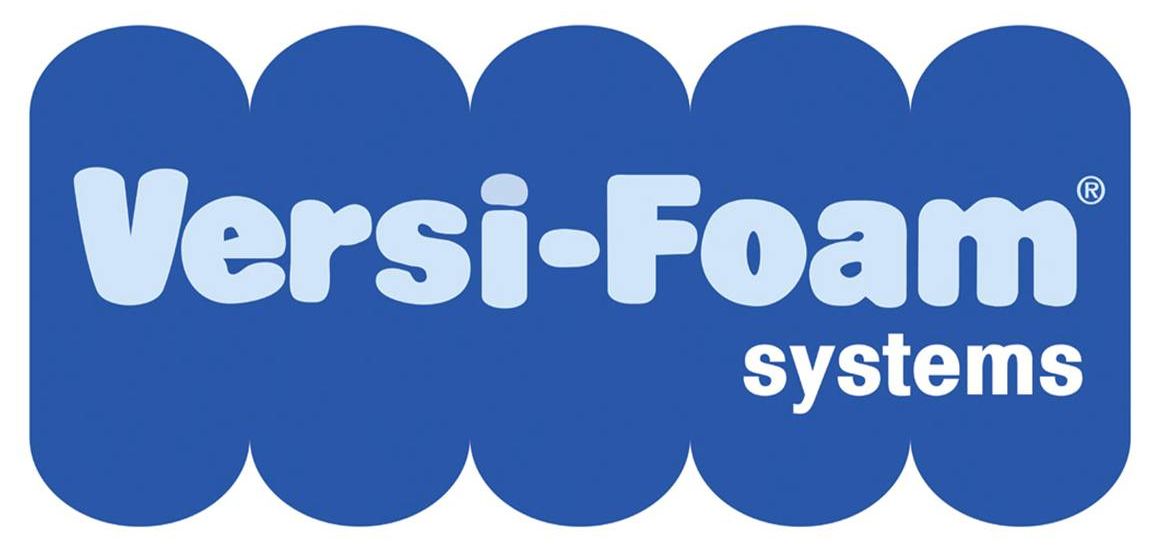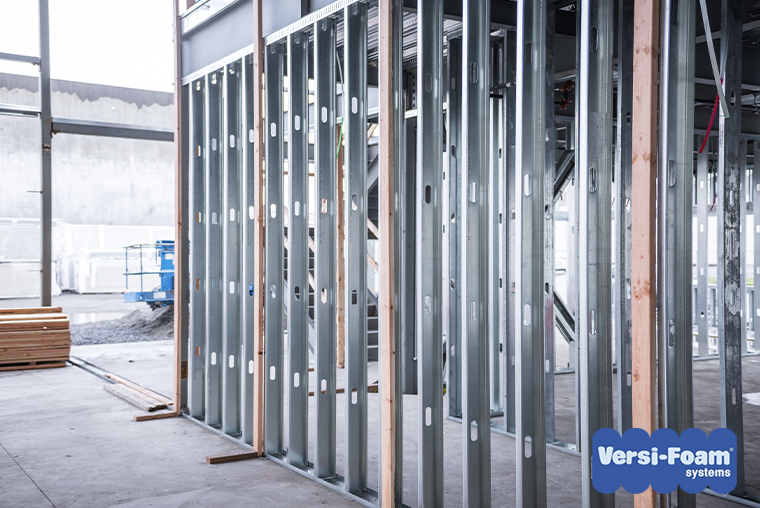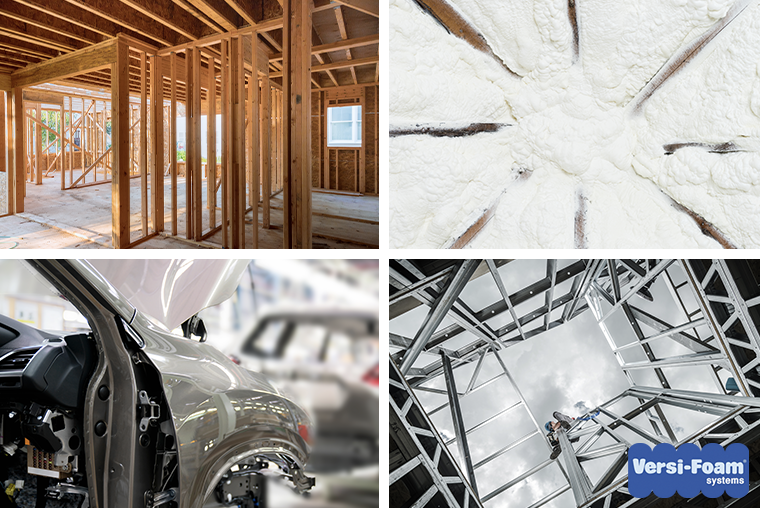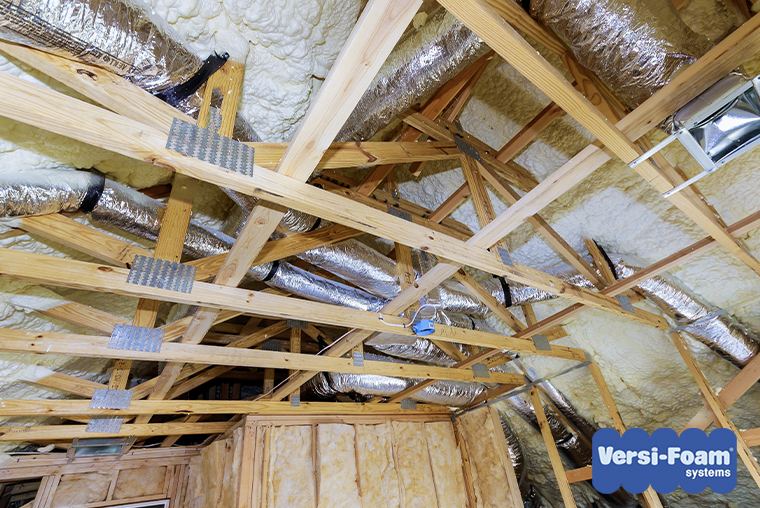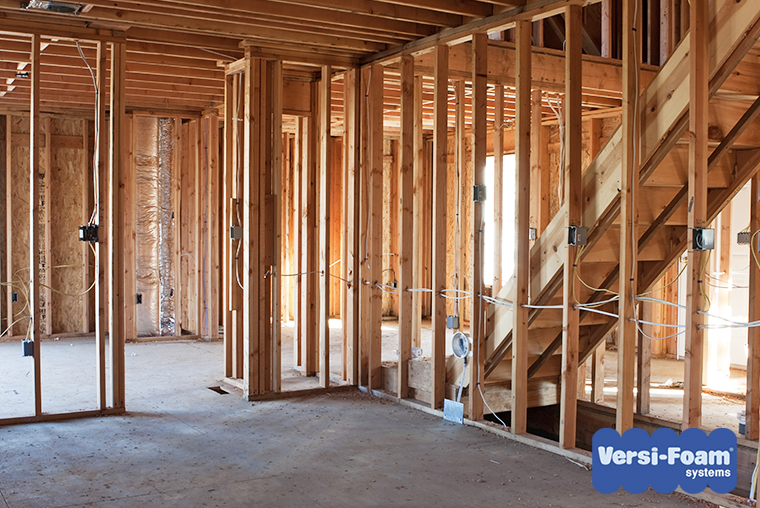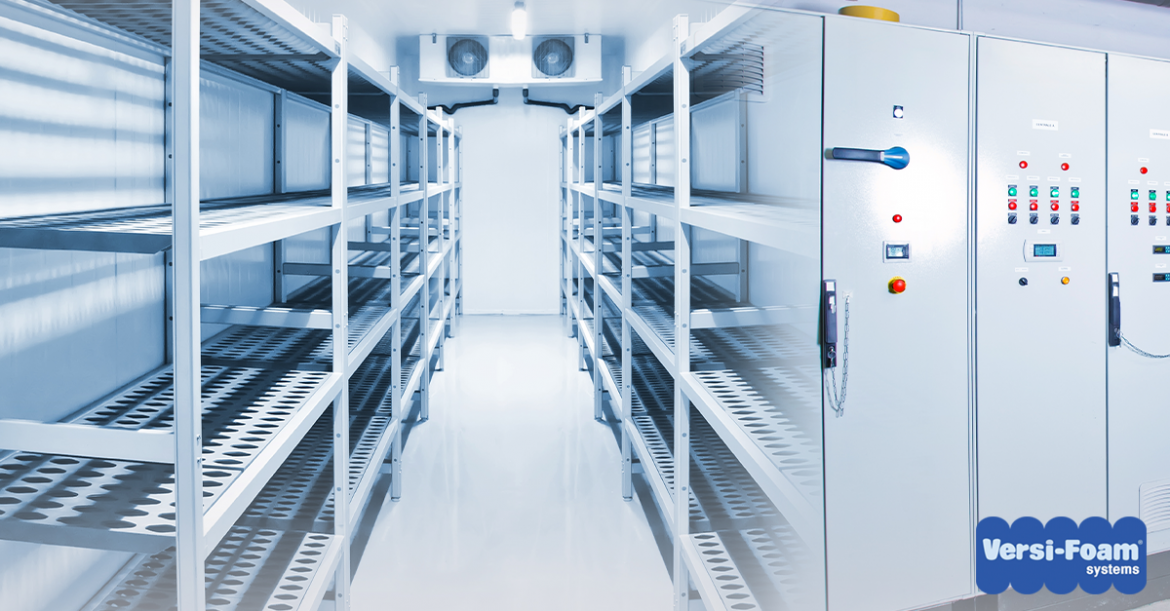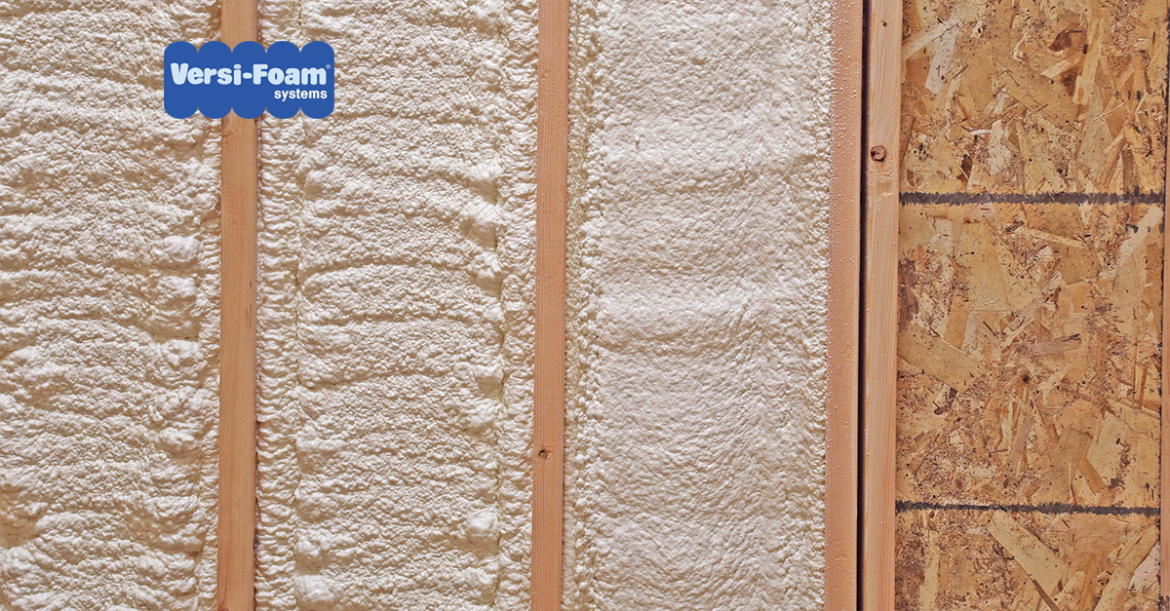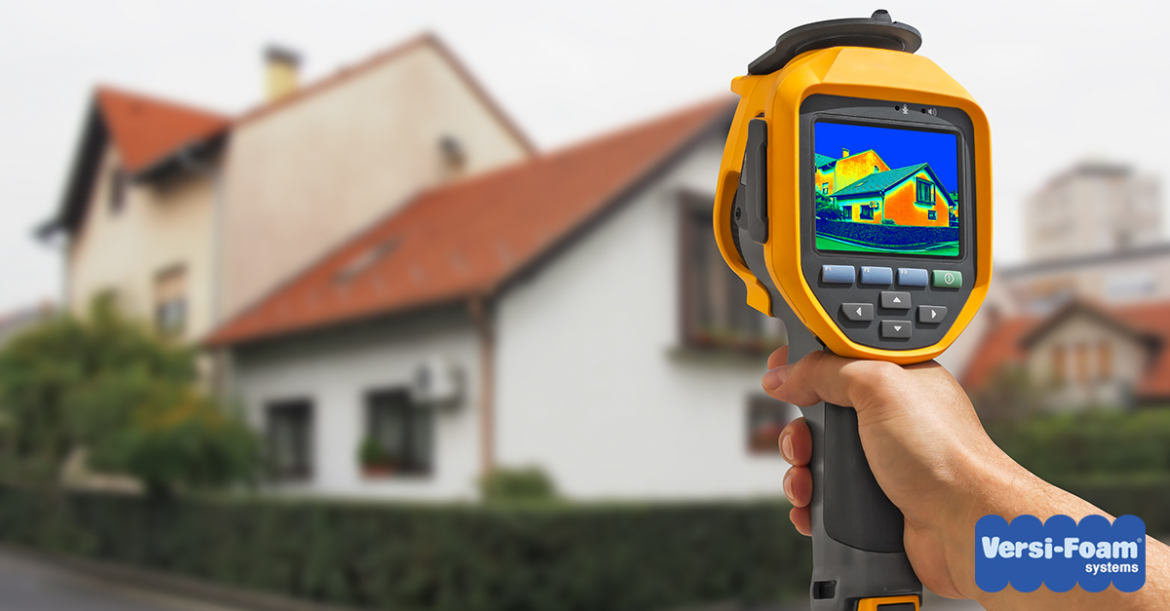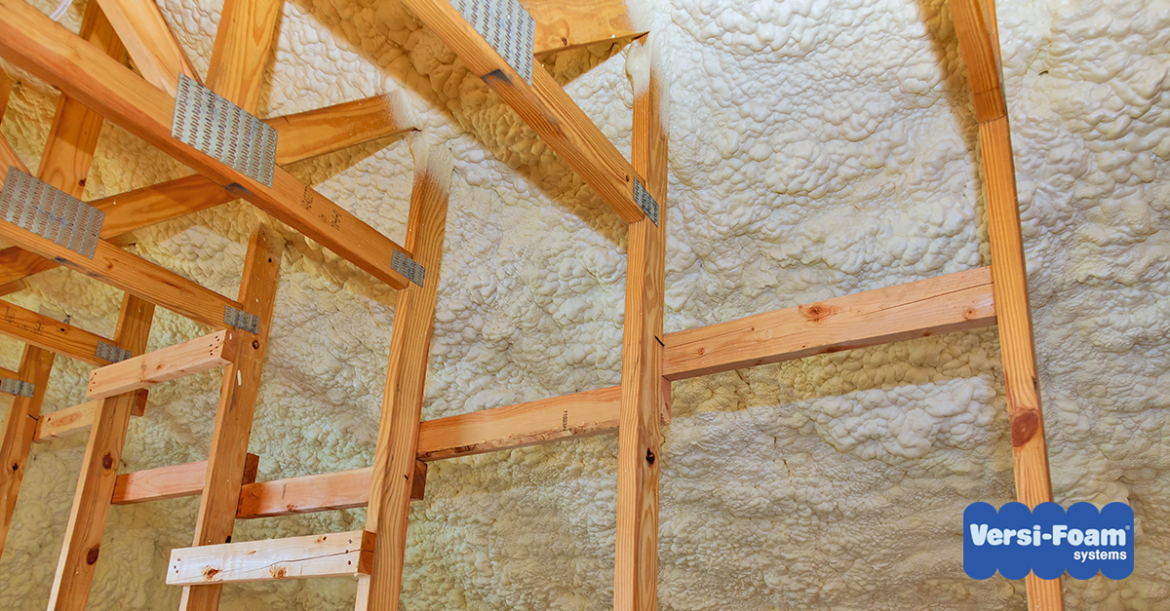VERSI-FOAM® LATEST NEWS
Spray polyurethane foam (SPF) was one of the greatest advancements in building insulation during the 20th century.
SPF is created when isocyanate and polyol resin are mixed with each other. The chemical reaction causes the compound to expand up to 30-60 times its liquid volume after spraying. Once it hardens and cures, it creates an air, moisture, and vapor barrier, making it one of the most effective insulation products available today. It has an interesting story.
Early Development of Spray Polyurethane Foam
The formula was originally developed by Otto Bayer in 1939 and quickly put to use by the military as a replacement for rubber. Like many things, the effectiveness of spray polyurethane foam as an insulator was stumbled upon accidentally. In 1957, it was used on a rail car with a leaky roof and ended up lasting for many years, which caught the attention of scientists.
In the early days it was applied by mixing it in a container, which was messy and inefficient, and which limited its widespread use. In 1953, Charles Baughman invented the “Blendometer”, the first machine to mix the two components together on-site.
In the 1960s, a machine to both mix and spray the foam was developed by Fred Gusmer and Fred Werner. “Known as the FF, it was the first dedicated foam machine on the market. Gusmer also developed the model-C gun, which in turn became the model-D gun, and dual heated hose assemblies that could be adjusted via thermostat.”
Commercial SPF Use
In the 1980s, spray polyurethane foam started to be used extensively in the roofing industry. During this time, while working on metal building roofing applications, Richard Heitzer realized that a better dispensing tool was needed. He designed and patented the U-control gun that allowed users to control the rate that the foam was dispensed, and founded RHH Systems in 1981.
Today, there is a wide range of how much SPF will be needed for any particular project — as small as sealing a single attic or as large as insulating an entire subdivision of new homes. No matter how large the project, the method of dispensing is still the same. The two chemicals are delivered to the jobsite separately and are mixed at the moment of application.
Spray Foam Kits Supplement Rigs
Methods of application vary depending on the size of the project. Very large projects required rigs which have enormous tanks and long, heated hoses. They pull up next to a building and heat the chemicals to the right temperature before beginning the application.
The disadvantage of rigs is that they can’t get into tight places. Contractors find that they often can’t get the hoses up into the attic or move around easily in tight quarters. Smaller areas require a different solution and that’s where spray foam kits come in. They can even be used on forklift as the technician moves around filling in gaps and crevices.
At RHH Foam Systems we partner with contractors to supply the spray foam kits they need to ensure that their buildings are completely insulated.
Spray foam kits are delivered to job sites on pallets of 12 for larger kits such as the System 50. System 15s are delivered 30 to a pallet. The product is purchased through our distributors. Sometimes distributors will deliver pallets directly from their warehouse and sometimes they will ask us to deliver the product to the jobsite for them.
We work hand-in-hand with our distributors and their customers to ensure that they have the spray foam insulation they need when they need it. If you aren’t currently working with one of our distributors, visit our dealer directory to find the distributor closest to you or call us directly at 1 (800) 657-0702.
Versi-Foam® spray foam insulation comes in four different product formulas: closed cell, open cell, slow rise, and high density. Each formula has been developed for certain specific applications and has its own unique uses. If you’ve ever asked yourself, “Which spray foam insulation should I use in my situation?”, this blog was written for you.
When should I use closed cell spray foam?
Closed cell spray foam is uniquely designed for times when a water, vapor, or air barrier is needed. It’s also the best choice when energy efficiency is high priority because of its greater r-value.
In addition, it adds strength to walls. However, it should not be sprayed into the enclosed cavity between the exterior wall and drywall. Rather, it can be sprayed between the exterior wall and the drywall if it’s done before the drywall is put up.
Closed cell spray foam is the right insulation choice in the following circumstances:
- Basements and crawl spaces
- New construction and remodeling
- Commercial and industrial buildings
- Tiny homes (because of its lower expansion rate)
- Outbuildings such as sheds and pole barns
When should I use open cell spray foam?
Open cell spray foam is best used in residential applications because of its cost effectiveness and sound dampening capabilities. It is a thicker, softer material and can completely fill the area between the studs, inhibiting the transfer of sound between rooms.
It’s especially well suited for unvented attic applications and sealing the underside of roof decks. It doesn’t provide a water barrier and so is not a good choice in places where dampness is a problem, such as basements and locations with high humidity. Consider open cell spray foam insulation for the following projects:
- Attic insulation
- Home and garage roof decks
- Residential insulation in milder climates
- Any project where small openings need to be sealed
When should I use slow rise spray foam?
Slow rise spray foam is a closed cell foam that becomes tack-free in about three minutes, instead of the 30-45 seconds for standard spray foam. This makes it perfect for insulating closed cavities, blind cavities and difficult to reach voids where the foam needs extra time to completely fill the area. Choose slow rise spray foam to insulate:
- Boats and other marine vehicles
- Existing homes and buildings
- Remodels
- Vehicles and trailers
When should I use high density spray foam?
High density spray foam is a closed cell foam with a density of 2.8 lbs. per cubic foot, compared to 2 lbs per cubic foot in standard closed cell spray foam. It’s used in projects where a higher r-value is needed to lower energy costs for the lifetime of the building. It also provides extra strength and load support to a structure. In fact, it’s often called “roofing foam” because it’s used on the exterior of flat roof buildings and can reduce wind damage to the roof. Choose high density spray foam for:
- Exterior applications
- Roofing applications
- Flat roof commercial and industrial buildings
- Metal building roofs
- The exterior of cryogenic tanks of space vehicles
Spray foam insulation is incredibly versatile and is recommended by construction professionals for its energy efficiency and long life. If your project isn’t on this list, please call us to talk more about your specific needs. (800) 657-0702
The attic is the first place you should insulate in your home. It’s one of the most cost effective steps you can take to reduce your energy costs. Furthermore, spray foam attic insulation acts as both an air barrier and a thermal barrier, making the attic comfortable to be in even if it isn’t used as a living space.
History and Vented Attics
Most of us love the idea of an attic. It’s a place of imagination, creativity, and also mystery. From Josephine March to Mrs. Rochester to Laura Ingalls, the attic is a retreat, sometimes freely chosen and sometimes not. At the very least, it is a place to store memories and things with sentimental value.
Throughout history, attic spaces were almost always vented. “The earliest attics followed the traditional or agricultural model, in which attic openings served to intentionally ventilate the entire building. This paradigm lies behind the expression, ‘A building has to breathe.’” In the 19th century, roofing materials were porous as well.
As building technologies advanced, materials became less permeable. Insulation came into use at the beginning of the 20th century and grew significantly during the energy crisis of the 1970s. Initially insulation was installed on the floor of the attic, to keep the conditioned air in the living spaces from escaping through the roof, while the attic itself remained vented.
Transition to Unvented Attics
More recently, experts in construction and architecture are recommending unvented attics as the most economical and healthy approach to attic insulation. Unvented attics use spray foam insulation on the roof deck, and to seal and fill all cracks, crevices, and openings from the attic to the outside. Fiberglass or cellulose insulation is not used on the floor of the attic once it has been sealed, making the attic part of the conditioned area of the home.
While an unfinished, unvented attic won’t be heated and cooled to the same comfort level as the main living areas, it also won’t experience the same temperature extremes as a vented attic will. The attic’s temperature is controlled by the conditioned space below it. Because there is less variation between the living areas and the attic, the house stays warmer with less energy use. As an added bonus, if the HVAC equipment is kept in the attic, it will be protected from temperature extremes, not need to work as hard, and have a longer life.
R-Value and Attic Insulation
In order to make the best decision about attic insulation, it is necessary to understand r-value. R-value is the capacity of an insulating material to resist heat flow and the primary measurement of energy efficiency. A higher R-value equals higher resistance to heat transfer. Insulation with a high R-value will keep warm air from escaping your house in the winter and entering it in the summer. When it comes to R-value, spray foam attic insulation is the clear winner, with the r-value of open cell spray foam at 4 per inch and with closed cell spray foam boasting a whopping 7.7 per inch r-value.
In addition to having a higher r-value and providing an effective air barrier, spray foam attic insulation has several other advantages. When applied properly, it’s a permanent solution that will last for the life of your home. Open cell spray foam has excellent sound dampening properties. It creates a barrier which absorbs noise, inhibits the transfer of sound between rooms and reduces noise that enters the building from the outside. It also has a high expansion rate to completely seal openings at a cost-effective price.
Spray Foam Attic Insulation
With some exceptions, experts recommend open cell spray foam for insulation in unvented attics. In the presence of moisture, this low density foam will dissipate the moisture quicker than closed cell foam. Spray foam attic insulation is often used on the underside of the roof deck. It can be sprayed in holes in the ceiling around electrical boxes and wiring, HVAC exhaust fans, attic hatches and chimneys. It can also be easily applied to shrinkage cracks between the framing and interior finishes on partition walls.
For more information on shingle warranties and ignition barriers, read the attic insulation section on our residential applications page. Attic insulation is especially important in areas of the country where seasonal temperatures are more extreme. If you don’t already have spray foam attic insulation, discuss your project with a Versi-Foam® dealer near you or call us to talk about keeping your home cozy this winter.
Concrete is a poor insulator—in fact, the concrete in your basement probably has an R-value of 1.1. That is about the same as the R-value of four inches of air space or one inch of plywood. Unless you want to feel unnecessarily cold all winter long, you’ll need more R-value in your basement than that. Before the cold weather creeps in this year, learn how to prevent heat loss in your home with Versi-Foam®.
Prevent heat loss with spray foam insulation
All basements experience some type of heat loss because heat travels from warm to cold. Depending on how much of your basement is above ground and how much is above the frost line, the difference between the temperature of the air in your house and the temperature of the ground around the basement could be anywhere between 20° and 50°.
When you use spray foam insulation on the walls of your basement, and to seal the gaps in the area above the sill and along the rim joists, it can reduce heat loss by as much as 30% to 40%, saving money on heating bills. A warmer basement also helps keep the rooms above the basement warmer. Eventually, the money you save will pay for the cost of insulation.
Control dampness and pests
Furthermore, dampness is almost always a problem in basements. Closed cell spray foam insulation prevents moisture problems and is not susceptible to mold, unlike fiberglass or cellulose which trap moisture and encourage mold growth.
SPF also helps prevent pest problems. Rodents can’t tunnel their way through the insulation as they can with other materials, and insect-sized gaps can be completely sealed because spray foam expands to fill openings as it hardens completely. It’s the only type of insulation with those properties.
Building Science Corporation has a good primer on insulating basement walls and detailed diagrams for how it should be done. In most modern homes, the basement walls will have been insulated in some fashion when the house was built and it’s probably not something you need to add to your list this winter.
However, problems can arise as the house settles over time. Cracks, gaps, and other small openings can appear in the sill plate where the walls meet the foundation, the rim joists that sit on the sill plate, and the concrete itself. In addition, there are HVAC penetrations and other openings between the basement ceiling and the floor above and loose-fitting heating ducts.
The Best Choice For Basement Insulation
Spray foam insulation is ideal for small-to-medium openings that nearly always occur in basements. The expanding properties of spray foam make it easy to thoroughly seal gaps in difficult-to-access places such as rim joists and sill plates. These areas are especially leaky and should be sealed on top and bottom. When you’re sealing HVAC openings, don’t forget the areas where phone and cable cords have been run through the walls. The reward for your thoroughness will be more comfortable living spaces above the basement.
Insulating the basement is one of the easiest ways to improve your home’s energy efficiency. After all, just because you don’t feel cold doesn’t mean the heater isn’t running too much. The coldest season of the year is just around the corner, so don’t delay getting your basement winter ready. The cost of time, effort, and money will be well worth it.
Most people don’t realize how complex and fragile a cold supply chain is. Cold chain management is an intricate process that ensures that temperature-controlled products, such as pharmaceuticals and food, remain at their prescribed temperature range from start to finish. Cold storage insulation is a critical component in the design of the cold storage supply chain.
Great effort is expended to ensure that the cold chain remains unbroken from start to finish. Before and after transport, perishable products are stored in facilities where the optimal temperature can be tightly controlled and carefully monitored. These buildings are the first and last links in the cold supply chain.
“Temperature-sensitive products—everything from meat and fish to certain chemicals and pharmaceuticals—require controlled environments from the moment they’re manufactured until the moment they’re used or sold.”
Cold Storage Insulation
Most cold storage facilities are constructed using pre-insulated sandwich panels. Sandwich panels are modular, heat resistant, and provide an excellent air barrier. However, at transitions between the panels or unsealed openings, warm, moist air can infiltrate. Avoiding these types of thermal leaks is imperative in cold storage design so that the facility has a tight building envelope and continuous vapor barrier.
Continuous thermal insulation maintains cold temperatures by preventing the travel of heat between spaces through the invisible process of air exchange. If cold air is allowed to leak outside of the cold storage facility, an equal amount of hot, humid air will enter to replace the cold air that was lost. The space needs to be completely enclosed so that it can be held at the required temperature 24 hours a day, seven days a week, and 365 days a year.
Once the sandwich panels are installed, any gaps that allow the exchange of hot and cold air must be sealed completely. In “The do’s and don’ts of cold storage”, author Jennifer Carr encourages contractors to pay close attention to every little opening and penetration. “As you’re making the various transitions, it’s often hard to find board insulation that gets into all the “nooks and crannies.” That’s why it’s important to use foam-in-place insulation at transitions between the wall and roof to maintain a continuous thermal envelope.”
Versi-Foam® For Cold Storage
Foam-in-place insulation is a spray polyurethane foam like Versi-Foam®. It’s used to seal the juncture where the roof meets the wall, wall and ceiling junctures on the interior, floor to wall junctions, and in corners. It expands to fill the entire space where it’s applied, sealing cracks and crevices completely. The closed cell formula protects against the incursion of heat and moisture proving the tight envelope and vapor barrier that’s required in a cold storage facility.
Versi-Foam® spray foam insulation kits offer the following advantages for cold storage insulation:
- Exceptional thermal performance.
- Advanced dispensing capabilities provided by our patented U-Control gun.
- Portable, with no outside power or pressure source needed.
- Superior adhesion to metal and other building materials.
Cold supply chains are an indispensable part of modern life. The ability to maintain low enough temperatures to preserve food and medicine for long periods of time has had a positive impact socially and economically compared to a century ago. Versi-Foam® is proud to play a small part in the cold storage supply chain by providing thermal insulation for low temperature warehouses.
Most of us like to keep on doing what we’re doing. Isaac Newton saw this and turned it into the first law of motion: an object at rest tends to stay at rest. When it comes to spray foam kits, that tendency could keep you from discovering a better way to insulate.
Humans are generally wary of the new and unfamiliar. If you’ve only heard about spray foam insulation kits but never watched them being installed or attempted to do it yourself, it can seem daunting. We’re here to reassure you that it’s not. The advantages of a Versi-Foam® spray foam kit are worth the effort it takes to venture into unknown territory.
We have customers who have been using Versi-Foam® for many years. They love it because they say the quality of the product is outstanding and the price helps them stay competitive. And the foam expands to six times its original liquid volume, which makes it very cost-effective.
In addition, Versi-Foam® spray foam kits perform well in most climates and weather conditions. As long as you ensure that the chemicals are within the recommended temperature range of 65° F and 90° F before and during use, the installation should go smoothly.
As a low-pressure foam, it’s easy to use. The patented U-Control gun allows you to dispense the product at the rate you want without difficulty and it’s designed to be comfortable in your hand for long periods of time.
Applying Versi-Foam® is as easy as 1, 2, 3.
- Stand two feet away from your target. Pull the trigger on the gun all the way back and then ease it forward until you get the right level of flow.
- Spray a strip around the perimeter then, with a back-and-forth motion, fill the area from top to bottom with the insulation.
- Wait 30-45 seconds and Versi-Foam® will be tack free to the touch.
Remember, the faster you move your hand back-and-forth, the thinner the foam will be. If you need more than two inches of thickness, apply the spray foam in more than one pass.
Visit our FAQ page for detailed information and instructions and to watch one of our How-To videos.
According to the 2nd law of thermodynamics, hot air is a little like cold air’s kid brother. Heat wants to be everywhere cold is. In winter, warm air is trying to escape your home to get outside and be with cold air. In summer it’s the reverse. Warm air is trying to sneak in through every crack and crevice to be with cold air.
“Heat transfer occurs spontaneously from higher- to lower-temperature bodies but never spontaneously in the reverse direction. The law states that it is impossible for any process to have as its sole result heat transfer from a cooler to a hotter object.”
Spray Foam Insulation Prevents Air Exchange
Insulation is a thermal barrier. Think of a thermos. It keeps the heat of your soup from escaping out into the cooler air of the room and also keeps it from getting inside the thermos to warm up your iced tea. The same principle is at work in a comfortable home.
If it’s a hot and sweaty 90 degrees outside and you want to be a cool and comfortable 72 degrees inside your house, you’ll need to run the air conditioner. If your attic, roof, ceiling, doors, windows, walls, ducts, crawl space, and basement aren’t insulated, the heat will seep into your house, causing your air conditioner to have to run more and cost more money. It might even overwhelm the capacity of the air conditioner to keep the temperature at the level you desire — running constantly to try to keep the temperature at 72, but unable to get it any lower than 78.
As your home loses cool air, an equal amount of hot, humid air enters your home to replace the cool air that was lost. This invisible process called air exchange is typically one of the main contributing factors for hot, sticky homes during the summer.
Versi-Foam spray foam insulation expands to fill the entire space where it’s applied, sealing cracks and crevices and reducing the overall leakiness of your home. It also acts as a sound dampener and a barrier to pollutants.
Insulating the attic keeps the cool air down in your living spaces. When the sun beats down on your roof and the hot air tries to enter your house it’s stopped in its tracks by your spray foam insulation. Sealing windows and doors everywhere there is a space where sunlight is coming in creates a barrier to the intrusion of warm air from the outside during the summer.
Once you’ve made sure your house is insulated properly, don’t forget to keep the sun’s rays out by closing your drapes or blinds when the sun is shining directly on the window. You can also take advantage of the cool (and free) night air by opening doors and windows as soon as the air cools in the evening and closing them before bed. As always, switch off unused heat sources and use LED light bulbs.
Spray foam insulation plus common sense will keep you cool and comfortable inside no matter how hot it gets outside.
A car without insulation is basically a small metal room on wheels. It’s better than a horse and buggy in terms of speed, but not much else. New cars coming off of the assembly line are usually well-insulated. But if you own a classic car, especially a sport utility vehicle, that car probably hasn’t been insulated to the standards of 2020.
For a while, the tranquility of silence was only available on more expensive cars. But automakers have been steadily working to bring the comfort of high-quality insulation to economy cars. “Honda’s engineers started by adapting the platform from the Ridgeline pickup, with its improved rear suspension design that mitigates sound and vibration at the source. They launched what Martin calls a “comprehensive sealing strategy,” deploying paint sealers, insulating spray foam, and tape that expands when heated, so it fills gaps between the welded bits.”
Spray foam insulation is one of the best ways to insulate the voids of your car, giving you a quieter, temperature-controlled, more comfortable ride. It flows and forms to the shape of the cavity and doesn’t have to be painstakingly cut to size and molded by hand to fit into crevices. Most cars need to be insulated in the following places to provide the maximum amount of comfort.
Wheel Wells. This is a good place to start with insulation because it’s where most of the noise from the road gets through, especially on cars with large performance tires.
Door Panels. Mysterious rattling noises will often come from the area between the door panels. Once you remove the interior panel and clean the inside of the cavity, the doors can be easily insulated with slow-rise spray foam.
Floor. A poorly insulated floor can allow noise from the exhaust pipe to make conversation difficult. Applying a sound dampening material to the floor of your car is one of the best ways to make your family road trips more conversational.
Ceiling. In lower priced cars, the insulation in the roof of the car may be less than optimal for a quiet cabin. An extra layer of insulation here will provide noticeable benefits.
Under The Hood. Even if you’re proud of your loud, powerful engine, your neighbors may not be. Insulation under the hood will give you a quieter ride inside and out.
Spray foam insulation is used by some of the world’s largest auto manufacturers. If your automobile needs an upgrade to its insulation, explore the benefits and ease of use of Versi-Foam products.
Now may be the perfect time to tackle that home renovation project you’ve had on your bucket list. After all, if you’re handy, it often makes the most sense to remodel your current home instead of trading up to newer construction. If your house is drafty, needs an addition, or could simply use a green upgrade, it’s time to take a closer look at Versi-Foam® spray insulation.
When it comes to home renovation, spray foam insulation has some distinct advantages over other types of insulation. First of all, it’s user-friendly, even for people with no experience. It also dampens sound, protects against insects, and is moisture resistant. Furthermore, closed cell spray foam provides a higher R-value (the primary measurement of energy efficiency) than other types of insulation.
Does one of the following situations fit your circumstances? If so, set aside some time for remodeling before life gets busy again.
My House is Leaky
Depending on where you live, it’s probably been too cold to tackle your insulation project during the winter. Spray foam insulation needs to be between 65°F to 90°F to install properly. As spring approaches and temperatures rise, you won’t need to warm the chemicals before use. While drafty doors and windows are fresh in your mind, make a list, insulate the cracks and crevices, and check each one-off. Pretty soon your air conditioner will be working as efficiently in the summer as your heater will next winter.
My House Needs a Few Extra Square Feet
Is now the right time to build that home addition for your growing family? If so, you want it to be as well insulated as the rest of your house. That’s where spray foam insulation comes into play. Whether you’re adding a bedroom to the attic, finishing your basement, or even doing something as simple as adding a sunroom, Versi-Foam® is the easiest way to ensure that your new living space is comfortable.
My House Is Older and So Is My Insulation
So, you finally purchased that older home with the character and craftsmanship that you love. But the last time it was insulated was decades ago. Now is a good time to walk through the house checking the roof, basement, HVAC system, and attic to make sure that they’re insulated to 2020 standards. An added plus for older homes is that spray foam insulation absorbs noise from the outside and inhibits the transfer of sound between rooms.
My House Needs a Green Upgrade
Giving your house a green upgrade has been on your bucket list for several years. Perhaps now is the time to check it off your list. Remodeling for energy efficiency is a win-win. Spray foam insulation saves energy, reduces the use of fossil fuels, and helps to reduce global warming gasses. In addition, many green practices lead to better health and a higher quality of life. As a property owner, you can take care of the environment, have a more comfortable home, and save money — all at the same time.
With Versi-Foam®, adding “sweat equity” is no sweat. Our spray foam insulation kits are easy-to-use, convenient, and cost-effective for remodeling. Learn more by reading our blog post on Choosing The Right Spray Foam Insulation Kit, exploring our How-To Video Library, and then contacting a dealer near you.
